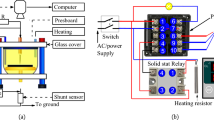Abstract
THE gassing tendencies of insulating oils used in the electrical industry are assessed by measuring the rate of gas evolution or absorption when they are exposed under an atmosphere of hydrogen in an electrodeless discharge tube of the Siemens Evers-type. Previous investigations1–4 have been confined to the investigation of a wide variety of commercial oils and the effect of additions of aromatic rich oil fractions and other additives chosen for their ability to impart a desirable hydrogen gas absorbing characteristic to the mixture. The different hydrocarbon types present in the oils, paraffins, naphthenes, olefines and aromatics cause the discharge reaction to be a complex competitive process in which the gas evolved by the paraffins and naphthenes is partially or completely absorbed by the olefinic and aromatic fractions. To avoid this complexity and enable a clearer understanding of the reaction processes to be reached, certain pure saturated and unsaturated hydrocarbons representative of the types found in oils have been selected for investigation. The experiments have shown that the discharge reaction is closely related to the corresponding radiolytic breakdown of simple hydrocarbons5.
This is a preview of subscription content, access via your institution
Access options
Subscribe to this journal
Receive 51 print issues and online access
$199.00 per year
only $3.90 per issue
Buy this article
- Purchase on Springer Link
- Instant access to full article PDF
Prices may be subject to local taxes which are calculated during checkout
Similar content being viewed by others
References
Bassaches, H., and Mclean, P. A., Indust. Eng. Chem., 47, 1782 (1965).
Church, H. F., and Garton, C. G., Proc. Inst. Elec. Eng., 100, IIA (528) (1953).
Clarke, S. A., and Reynolds, E. H., Dielectrics, 1, 26 (1963).
Nossier, A., and Lawrence, R., Nature, 206 86 (1965).
Black, R. M., and Reynolds, E. H., Proc. Inst. Elect. Eng., 112, 1226 (1965).
Hardwick, T. J., J. Phys. Chem., 64, 1623 (1960).
Hardwick, T. J., J. Phys. Chem., 66, 291 (1962).
Author information
Authors and Affiliations
Rights and permissions
About this article
Cite this article
CROSS, P. Breakdown of Simple Hydrocarbons subjected to a Silent Electric Discharge. Nature 208, 892–894 (1965). https://doi.org/10.1038/208892a0
Issue Date:
DOI: https://doi.org/10.1038/208892a0
Comments
By submitting a comment you agree to abide by our Terms and Community Guidelines. If you find something abusive or that does not comply with our terms or guidelines please flag it as inappropriate.



